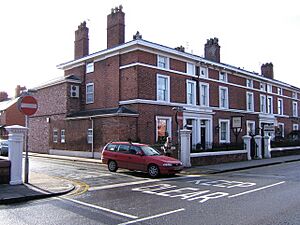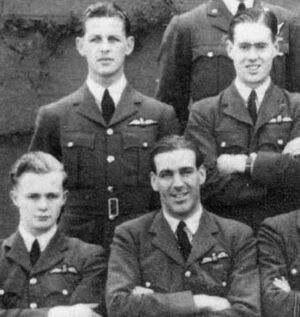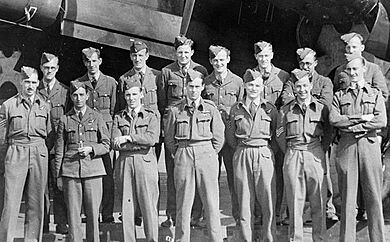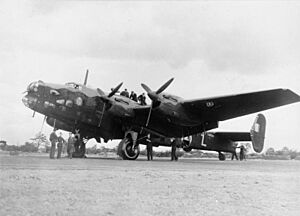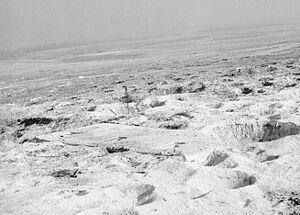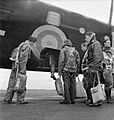Leonard Cheshire facts for kids
Quick facts for kids
The Lord Cheshire
|
|
|---|---|
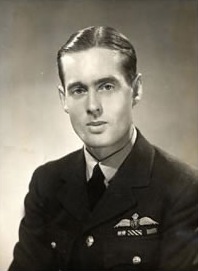
Wing Commander Leonard Cheshire in January 1943
|
|
| Born | 7 September 1917 Chester, England |
| Died | 31 July 1992 (aged 74) Cavendish, Suffolk, England |
| Buried |
Cavendish Cemetery
|
| Allegiance | United Kingdom |
| Service/ |
Royal Air Force |
| Years of service | 1937–1946 |
| Rank | Group captain |
| Service number | 72021 |
| Unit | No. 102 Squadron RAF No. 35 Squadron RAF |
| Commands held | No. 617 Squadron RAF (1943–44) RAF Marston Moor (1943) No. 76 Squadron RAF (1942–43) |
| Battles/wars | Second World War |
| Awards | Victoria Cross Member of the Order of Merit Distinguished Service Order & Two Bars Distinguished Flying Cross Mentioned in Despatches |
| Spouse(s) |
Constance Binney
(m. 1941; div. 1951)Sue Ryder
(m. 1959) |
| Children | 2 |
| Relations | Geoffrey Chevalier Cheshire (father) |
| Other work | Humanitarian |
Geoffrey Leonard Cheshire, Baron Cheshire (7 September 1917 – 31 July 1992) was an amazing Royal Air Force (RAF) pilot during the Second World War. He was known for his incredible bravery and skill. After the war, he became a philanthropist, which means he dedicated his life to helping others.
Cheshire received the Victoria Cross, the highest award for bravery in the face of the enemy. He was the youngest group captain in the RAF and one of the most decorated pilots of the war. After the war, he started a nursing home that grew into the famous charity Leonard Cheshire Disability. He was also known for his work in solving conflicts. In 1991, he was made a life peer (given a special title in the British Parliament) because of his charity work.
Contents
- Early Life and Education
- Military Career Highlights
- Post-War Humanitarian Work
- Christian Faith
- Private Life
- Death and Legacy
- Honours and Tributes
- Images for kids
Early Life and Education
Geoffrey Leonard Cheshire, known as Leonard, was born in Hoole, Chester, England. His father was a lawyer and writer. Leonard's mother named him after her brother, who died fighting in 1917. Leonard had a younger brother, Christopher, who also became a bomber pilot during the war.
Leonard grew up near Oxford and went to the Dragon School and Stowe School. He was good at lawn tennis and enjoyed reading and natural history. In 1936, he visited Germany and saw an Adolf Hitler rally. He bravely refused to give the Nazi salute, which caused some trouble.
In 1936, he started at Merton College at the University of Oxford. He joined the Oxford University Air Squadron to learn basic flying skills. He graduated in 1939.
Military Career Highlights
Joining the Royal Air Force
On 16 November 1937, Leonard became a pilot officer in the Royal Air Force Volunteer Reserve. He initially joined to avoid university exams, but his father insisted he finish them. On 7 October 1939, he officially joined the RAF. He wanted to be a fighter pilot, but was sent to Bomber Command instead.
Flying with 102 Squadron
In June 1940, Cheshire joined 102 Squadron, flying the Armstrong Whitworth Whitley bomber. He learned a lot from his mentor, Hugh "Lofty" Long. Long taught him to know his aircraft inside out and to care for his crew. Cheshire flew his first ten missions as a second pilot with Long. By June, he was commanding his own aircraft.
Bravery and the DSO Award
On the night of 12/13 November 1940, Cheshire was on a mission to bomb a German oil plant. His plane was badly hit by anti-aircraft fire, causing a huge tear and a fire. Even though he was temporarily blinded and his plane was falling, he managed to regain control.
Despite the damage, Cheshire decided to return and bomb his target. He faced heavy enemy fire but successfully dropped his bombs. He then managed to fly his damaged plane and crew safely back to base in England. For this incredible bravery, he was awarded the Distinguished Service Order (DSO). After completing his first set of missions in January 1941, he immediately volunteered for more.
Missions with 35 Squadron
In January 1941, Cheshire moved to 35 Squadron, which was using the new four-engine Handley Page Halifax bomber. He flew seven raids on Berlin. He was promoted to acting squadron leader in March 1941 and received the Distinguished Flying Cross (DFC). Sadly, his mentor "Lofty" Long was killed in action in March 1941, which deeply affected Cheshire.
In May 1941, Cheshire flew a Liberator across the Atlantic. While in New York, he met and married actress Constance Binney. After returning to England, he learned that his original crew from 102 Squadron had been lost on missions. By early 1942, he had completed 50 missions.
Becoming an Instructor
After his time with 35 Squadron, Cheshire became an instructor at Marston Moor. Even as an instructor, he still flew dangerous missions, including two of the first "thousand-plane raids" against German cities. During one of these raids in August 1942, his younger brother Christopher was shot down over Berlin and did not return.
Leading 76 Squadron
In August 1942, Cheshire was promoted to acting wing commander and became the commanding officer of No. 76 Squadron RAF. The squadron had suffered heavy losses and had low morale. Cheshire worked hard to improve it.
He often flew the most dangerous missions himself, sometimes as a "second pilot" to give new crews confidence. He also made changes to the Halifax bombers to make them fly higher and faster, which reduced losses and boosted morale. Cheshire made an effort to learn the name of every person on the base, from aircrew to ground crew. He believed this personal connection was vital for his squadron's success. He taught crews how to survive by flying through dangerous situations himself.
Youngest Group Captain
After completing his third tour of duty, Cheshire was no longer supposed to fly combat missions. However, he was promoted to acting group captain in March 1943, becoming the youngest group captain in RAF history at just 25 years old. He was then put in charge of Marston Moor, a training base. He found this administrative role frustrating, as he wanted to return to flying.
Joining 617 Squadron
Cheshire found a way back to combat by joining 617 Squadron, known as the "Dambusters." This elite unit was facing difficulties after losing its commander. Cheshire agreed to take a lower rank (wing commander) to lead them. He learned low-level flying techniques from the squadron's experienced pilots.
It was with 617 Squadron that Cheshire became famous for developing new ways to drop bombs with incredible accuracy.
Destroying V3 Guns
Cheshire's main mission with 617 Squadron was to destroy Germany's secret V3 long-range guns in France. These huge guns were buried deep underground and protected by thick concrete. To destroy them, a new, very heavy bomb called the Tallboy was created by scientist Barnes Wallis. These bombs had to hit very precisely.
Cheshire developed a new method for marking targets. Instead of dropping many markers from high up, he would fly a single, fast plane very low over the target. He would then drop a single, accurate marker flare directly onto the building. The main bombing force would then aim for that single marker. This was very dangerous but incredibly accurate.
Success at Limoges
On 8/9 February 1944, Cheshire used his new method against the Gnome et Rhône aero-engine factory in Limoges, France. The factory was surrounded by homes, and workers were inside. Cheshire made low passes to warn the workers, who then ran out. He then dropped a marker flare on the roof. The rest of 617 Squadron followed, dropping their bombs directly on the marker. The factory was destroyed with almost no civilian casualties. This was a huge success.
Munich Raid and Mosquitos
Cheshire wanted to use faster, more agile Mosquito aircraft for marking targets. The head of Bomber Command, Arthur Harris, challenged him: "Mark me Munich and I will give you the Mosquitos. Miss Munich and you will lose the Mosquitos."
On 24/25 April, four 617 Squadron Mosquitos, including Cheshire's, set out to mark the rail yard in Munich. Despite intense anti-aircraft fire, Cheshire dove low and dropped his marker precisely. The main bomber force then destroyed the rail yard. All four Mosquitos returned safely, and Harris kept his word, allowing Cheshire to keep them.
D-Day Deception Mission
To help the D-Day landings, 617 Squadron was given a unique mission. They had to create a "spoof" raid to confuse the Germans about where the real invasion would happen. On the night of 5/6 June 1944, 617 Squadron flew low over the English Channel, dropping chaff (strips of metal that confused radar). This made it look like a large invasion fleet was heading for the Pas de Calais region, far from the actual D-Day beaches. Cheshire believed this mission saved more lives than any other they did.
Destroying V-Weapon Sites
After D-Day, 617 Squadron continued to attack German V-1 and V-2 storage sites, destroying bunkers at Wizernes and Watten. They also attacked E-boat pens at Le Havre, using Tallboys to cave in the roofs and damage the boats. They even dropped Tallboys into the harbor, causing explosions that blew ships out of the water. Cheshire commented, "Barnes Wallis had a big bomb."
On 25 June, Cheshire used a Mustang fighter plane to mark a V-1 bunker. He had to learn to fly it quickly, as he hadn't flown a single-seat plane since training. He successfully marked the target, and three Tallboys destroyed it completely.
Final Missions and Victoria Cross
On 6 July 1944, Cheshire finally attacked the Mimoyecques V-3 site, the mission he had been waiting for. He marked the target for 617 Squadron, and the Tallboys caused the caves to collapse, ending the V3 threat.
His 100th mission, and his last with Bomber Command, was on 7/8 July against a limestone cave storing V-1s and V-2s at St. Leu d’Esserent. He flew his Mustang as the target marker. The Tallboy strikes blocked the tunnels. The next day, Cheshire was taken off combat missions.
In July 1944, Cheshire was awarded the Victoria Cross. This award was given for his incredible bravery and leadership throughout his entire operational career, not just for one specific act.
Witnessing Nagasaki
Cheshire was an official British observer of the nuclear bombing of Nagasaki in August 1945. He was in a support plane, but due to a mix-up, he didn't see the explosion as closely as planned. He later said, "with such utter devastation before our eyes, how imperative to do something to see that it should never happen again."
After the war, Cheshire was eager to return to England. He reported on his Nagasaki experience to the new Prime Minister, Clement Attlee. Cheshire suggested that future peace depended on developing atomic energy for space travel. He was retired from the RAF in January 1946 due to stress, but kept his rank of Group Captain.
Cheshire as a Leader
Cheshire was not a naturally gifted pilot, but he was a great leader. He was known for being lucky, and crews liked flying with him because of it. He believed his luck kept him alive when many others were lost.
He faced dangerous situations head-on, believing that worrying only made things worse. He could block out the risks and approach each mission calmly. Unlike some commanders, Cheshire was approachable. He made an effort to know every man on his base, including the ground crews. He would talk to them about their concerns, building strong loyalty. He believed this was key to his squadron's effectiveness. He led by example, inspiring his crews to perform their best.
Cheshire was also very strict with anyone who showed a "lack of moral fibre" (LMF), meaning they were too afraid to fly missions. He would try to help those with confidence issues, but pilots who refused to fly were quickly transferred out. He was a quiet, thoughtful man, but also very independent and unconventional in his thinking.
Post-War Humanitarian Work
Founding Leonard Cheshire Homes
After the war, Cheshire searched for a new purpose. He wanted to create a community for ex-service members to help them adjust to civilian life. He started a project called 'Vade in Pacem' (Go in Peace) at a house called Le Court in Hampshire. This community didn't last long.
However, in 1948, Cheshire heard about Arthur Dykes, a former member of his community who was dying of cancer. Cheshire invited Dykes to stay at Le Court and nursed him. Soon, others needed help, and Le Court began taking in more patients, including a 94-year-old woman recovering from a stroke.
Cheshire realized there was a big need for care that the new National Health Service (NHS) wasn't providing, especially for disabled people. Le Court became a home where people with complex needs could live together and make friends. Even though there was little money, help always seemed to arrive. As word spread, other communities across the UK started similar homes. This led to the creation of the charity now known as Leonard Cheshire. Le Court was the first "Cheshire Home."
Other Charities and Peace Work
Cheshire dedicated his life to peace and justice, believing that peace comes from removing injustice, like starvation and poverty. He founded several charities:
- In 1948, his main charity, Leonard Cheshire, began. It supports people with disabilities worldwide to live, learn, and work independently.
- In 1953, he founded the Raphael Pilgrimage to help sick and disabled Christians travel to Lourdes.
- In 1959, with his wife Sue Ryder, he founded Ryder-Cheshire for joint projects. This started with Raphael in India, which helped people with leprosy and tuberculosis. Today, it helps children with learning disabilities and TB.
- In 1990, he founded the World Memorial Fund for Disaster Relief, focusing on helping disabled people affected by disasters. To raise money, a concert by Pink Floyd member Roger Waters, The Wall – Live in Berlin, was held in Berlin. Cheshire opened it by blowing a Second World War whistle.
Cheshire's ideas also influenced the creation of the National Memorial Arboretum, a place for remembrance in Staffordshire, England. The amphitheater there is dedicated to his memory.
Christian Faith
Cheshire became a Roman Catholic in 1948. This decision was influenced by his experiences during the war and discussions with Arthur Dykes, whom he nursed. He was also inspired by a book about converting to Catholicism. On Christmas Eve 1948, he officially joined the Catholic Church.
He had a special interest in the Holy Shroud of Turin, a famous cloth believed by some to be the burial cloth of Jesus. In 1954, he took a disabled girl on a pilgrimage to Turin, where she touched the Shroud. She later recovered from polio, which her family attributed to this act of faith. Cheshire himself believed his recovery from a serious tuberculosis infection was helped by a replica of the Shroud.
Private Life
On 15 July 1941, Cheshire married American actress Constance Binney. They divorced in 1951.
On 5 April 1959, he married Sue Ryder, who was also a humanitarian and a Roman Catholic convert. They had two children, Jeromy and Elizabeth. They lived in Cavendish, Suffolk. Both Leonard and Sue held special titles in their own right.
Cheshire loved tennis his whole life and was a good amateur player even in his seventies.
Death and Legacy
After being diagnosed with motor neurone disease, Leonard Cheshire and Sue Ryder made a final trip to their Raphael Centre in India. This journey was shown in a film called 'Indian Summer'.
Cheshire was determined to attend the unveiling of Arthur "Bomber" Harris's memorial on 31 May 1992, despite his doctors' advice. He died two months later, on 31 July 1992, at his home in Cavendish, Suffolk, aged 74. He is buried in the graveyard at St Mary's Church in Cavendish, next to Sue Ryder, who died in 2000.
Honours and Tributes
- In 1960, he was featured on the TV show This Is Your Life.
- On 17 July 1991, he was made Baron Cheshire, a life peer in the British Parliament.
- Queen Elizabeth II paid tribute to him in her Christmas message in December 1992.
- In a 2002 BBC poll, Cheshire was voted the 31st Greatest Briton.
- His Victoria Cross medal is on display at the Imperial War Museum, London.
- His old school, Stowe, named a new house after him in 2019.

| Victoria Cross (VC) | 8 September 1944 | |
| Member of the Order of Merit (OM) | 13 February 1981 | |
| Companion of the Distinguished Service Order and Two Bars | 6 December 1940 | |
| Distinguished Flying Cross (DFC) | 7 March 1941 | |
| 1939–45 Star | ||
| Air Crew Europe Star | With 1 clasp Atlantic | |
| Burma Star | ||
| Defence Medal | ||
| War Medal 1939–1945 with oak leaf for being Mentioned in Despatches | ||
| Queen Elizabeth II Coronation Medal | (1953) | |
| Queen Elizabeth II Silver Jubilee Medal | (1977) |
Awards Received
- Distinguished Service Order (DSO): 6 December 1940, 20 April 1943, 18 April 1944
- Distinguished Flying Cross (DFC): 7 March 1941
- Mentioned in Despatches: 17 March 1941
- Victoria Cross (VC): 13 November 1945
- The Harding Award: 1978 (for outstanding work benefiting disabled people)
- Order of Merit (OM): 5 February 1981
Images for kids


